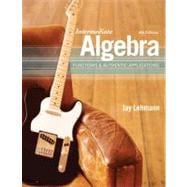Unique in its approach, the Lehmann Algebra Series uses curve fitting to model compelling, authentic situations, while answering the perennial question “But what is this good for?” Lehmann begins with interesting data sets, and then uses the data to find models and derive equations that fit the scenario. This interactive approach to the data helps readers connect concepts and motivates them to learn. The curve-fitting approach encourages readers to understand functions graphically, numerically, and symbolically. Because of the multi-faceted understanding that they gain, readers are able to verbally describe the concepts related to functions.
Introduction to Modeling, Operations and Expressions, Using the Slope to Graph Linear Equations, Simplifying Expressions and Solving Equations, Linear Functions and Linear Inequalities in One Variable, Systems of Linear Equations and Systems of Linear Inequalities, Polynomial Functions and Properties of Exponents, Factoring Polynomials and Solving Polynomial Equations, Quadratic Functions, Exponential Functions, Logarithmic Functions, Rational Functions, Radical Functions, Sequences and Series, Additional Topics For all readers interested in algebra.








